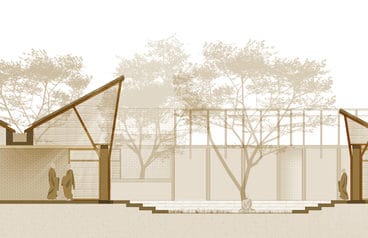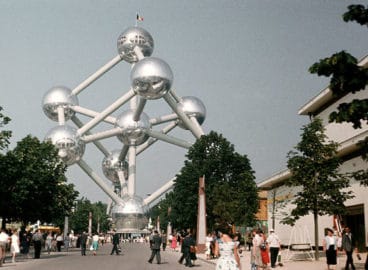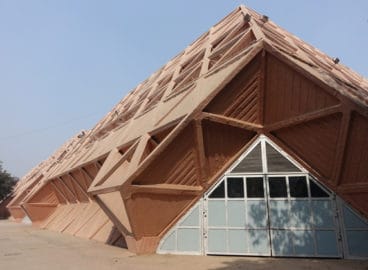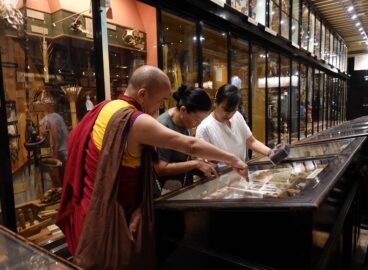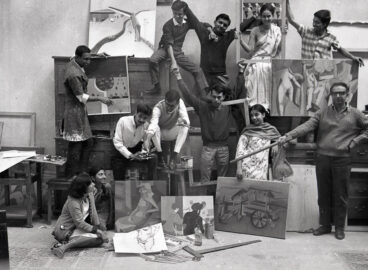Critic and curator Gayatri Sinha considers the Kochi-Muziris Biennale through the layered and evocative prism of history. The Kochi-Muziris Biennale has produced three exhibitions since its inception in 2012, with its fourth edition opening in December 2018. This essay sites the biennale within the historical context of the twin port cities of Kochi and Muziris, as well as within the recent burgeoning of the biennial as an international format for viewing “global” art and representing local identities.
If the decades of the 1950s and 1990s belonged to the Asian biennial, South Asia is exceptionally late in coming to the party. The biennial in Kochi, a port city in the southern state of Kerala, was initiated in 2012 by two artists Bose Krishnamachari and Riyas Komu. In its first three editions (2012, 2014, and 2016), it has established a model that defies conventional biennial wisdom, and has implicated the neighboring historic port city of Muziris within its own locus. The Kochi-Muziris Biennale broke with the paradigm of curators tied to major biennials, and to theoretical positions of curatorial logic, especially those of the Western curators who tend to dominate the East Asian circuit. Instead, it set for itself the challenging paradigm of the artist-curator, an insider in subcontinental politics, the region, and its history, both past and more recent. Equally, it broadly identified with the idea of parallel modernities in the global south and the global north.
Okwui Enwezor has said: “The biennial is an exhibition structure beyond itself, an event that allows for very different subject matter. Its function, as defined by planners and curators, is to add intellectual capital, to think about the relationship between the past and present, and to experiment with truths.”1Carolee Thea, “Okwui Enwezor,” in On Curating: Interviews with Ten International Curators (New York: D.A.P./Distributed Art Publishers, 2009), 10. How have these ideas been asserted in curatorial terms? Biennials such as Kochi-Muziris belong to the fourth wave of biennial formation since Venice was realized in 1895. Anthony Gardner suggests there are four stages of periodization in the rise of the biennial: the 1890s, 1950s, 1990s, and early 2000s, in which the Kochi-Muziris Biennale figures.2Anthony Gardner and Charles Green, Biennials, Triennials, and Documenta: The Exhibitions that Created Contemporary Art (Hoboken, NJ: Wiley-Blackwell, 2016). There are certain marks of this most recent period. The South Asian biennials that have followed the East Asian biennial boom of the 1990s are very much within the ambit of “Asianness” and Asian discourse. Coming more than a decade later, Kochi-Muziris takes on the questions: Is there anything particularly Asian in the biennials of Asia, such as the Busan or Gwangju biennials, with their panoply of international curators? How does Kochi-Muziris assert its own difference?
An inherent contradiction in Indian polity is that while the four southern states are better educated and wealthier, the north is the seat of political power.3The Southen states are: Andhra Pradesh, Tamil Nadu, Karnataka, and Kerala. The Kochi- Muziris Biennale, located in the southern peninsula, is as much an assertion of the south-north dialectic within India as it is a significant presence in the biennial dialectic between the global south and global north. The Kochi-Muziris Biennale is the first assertion of trans-nationalism from a region that has also challenged the hitherto entrenched authority of the center (i.e., New Delhi) in negotiating its regional-national and regional-global identity.
The question then arises whether the Kochi-Muziris Biennale in its three manifestations has offered an alternative paradigm. The critic Marek Bartelik has argued that South Asian biennials have failed to establish their own intellectual and critical identity, and that they rely on the Western enlightenment project rather than on their own intellectual structures and sources.4Marek Bartelik, “An Emerging Paradigm Derived from the Asian Biennials? The Case Studies of the Mediacity Biennial (Seoul), the Busan Biennale (Busan), the Gwangju Biennale (Gwangju), and the Taipei Biennial (Taipei),”Journal of Taipei Fine Arts Museum (2014). By implication, South Asian biennials have failed to add to the biennial discourse because they are mimetic. Kochi-Muziris is, by definition, a South Asian and Asian biennial. In the pairing of Kochi with Muziris, an ancient center for trade, it offers another dimension—that of a maritime cosmopolis with mercantile success and cultural complexity. Kochi’s twin port, Muziris, described by Pliny the Elder in the first century CE as “the nearest mart of India,” was a conduit for the lucrative pepper and spice trade with the West.5Pliny’s Natural History, trans. Henry T. Riley, vol. 6, An Account of Countries, Nations, Seas, Towns, Havens, Mountains, Rivers, Distances, and Peoples Who Now Exist, or Formerly Existed (London: H. G. Bohn, 1855), chap. 26 “Voyages to India,” http://data.perseus.org/citations/urn:cts:latinLit:phi0978.phi001.perseus- eng1:6.26. “If the wind, called Hippalus, happens to be blowing, it is possible to arrive in forty days at the nearest mart of India, Muziris by name.” In a rich cultural amalgam, Kerala witnessed the coming of Saint Thomas in the first century and the first migration of the Jews five hundred years before that. The Chinese used Kochi as a Keralan entrepôt for active trade for close to a millennium. Ma Huan, an Arabic-language translator and one of the four officials who accompanied the Chinese diplomat and fleet admiral Zheng He on his travels in the fifteenth century, wrote that from the Kerala ports of Kollam, Kochi and Kozhikode, pepper, coconut, fish and betel nut were exported in exchange for gold, silver, colored satin, blue-and-white porcelain, musk, quick silver and camphor.6Vijayalekshmy. M, Trade and trading centres in Kerala (A.D 800-1500) (Calicut, India: Department of History, University of Calicut, 1997), 211. Even today, many place names in Kerala are reminders of Chinese trade with the Malabar—for example, “Cinakota” meaning Chinese fort; “Cinecceri” meaning Chinese settlement; and “Chintapalli” meaning Chinese mosque.7K. V. Krishna Aiyar, The Zamorins of Calicut: From the Earliest Times Down to A.D. 1806 (Calicut, India: Norman Printing Bureau, 1935), 85. See also O. K. Nambiar, Our Seafaring in the the [sic] Indian Ocean (Bangalore: Jeevan Publications, c. 1975), 35.
Here it is also important to introduce the history of the kingdom of Kochi, also known as the Kochi swaroopam. In the era of colonization, Kochi became a longtime Portuguese protectorate. Later, Kochi entered into treaties of protection with the Dutch and then with the British East India Company, which lasted until Indian independence in 1947.
Does Kochi-Muziris thus represent a dyadic gaze back to both a Keralan past of profitable international trade along global sea routes and a regional cosmopolitanism that linked Kochi—a natural setting for the migration of Islam and Christianity—to the great Tang and Song dynasties of China, and the ports of Rome, Venice, and Antwerp? Does the fractured gaze also rest on the politics of India and the local-national debate that marks a resistance to the global north? In effect then, is Kochi-Muziris required to be a new amalgam of its cosmopolitan past, its regional present, and its left-leaning political orientation in a period of global capitalism?
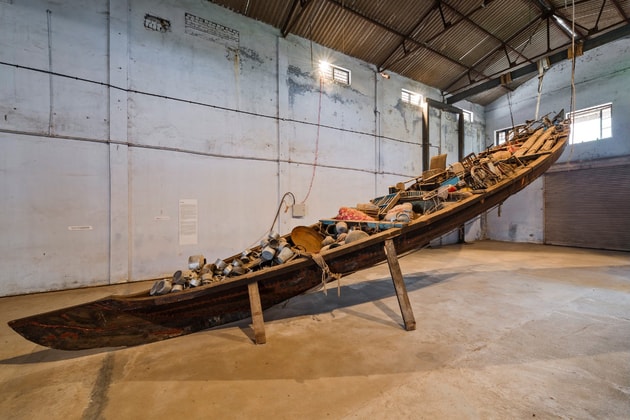
The history of an earlier cosmopolitanism guided the curatorial vision of the first three editions of the biennial. In the first biennial (2012), the theme of Kochi-Muziris as a cosmopolis at the intersection of migrating faiths, colonizers, and traders was emphatically brought home in Vivan Sundaram’s mock-archeological sculptural installation Black Gold (2012), constructed from pottery shards of Roman wine amphorae excavated from archeological sites in Muziris. Sundaram later created Black Gold (2014) as a multichannel video that integrates black pepper and the terra-cotta shards; shot on his studio floor in Delhi amid flowing and stagnant waters, the work evokes Kochi’s ancient engagement with global sea trade. In the same edition, Subodh Gupta’s magnificent What does the vessel contain, that the river does not (2012), a boat crammed with the humble belongings of the migrant, spoke of workers consigned to plantations in the East Indies. Representing the European settlements’ indentured labor, these articles mark the beginning of the large Indian diaspora. Embedded in these works are the idea of Orientalist fantasy, diaspora, and the echo of migration, which has reached new levels in the last decade.
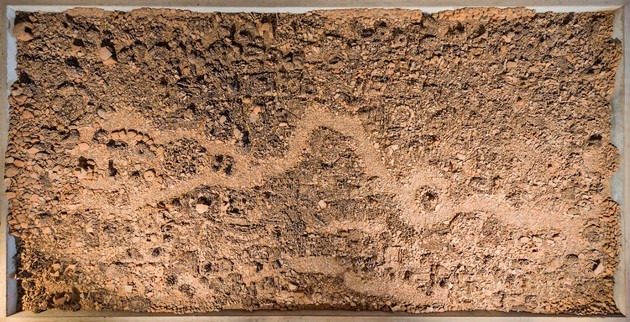
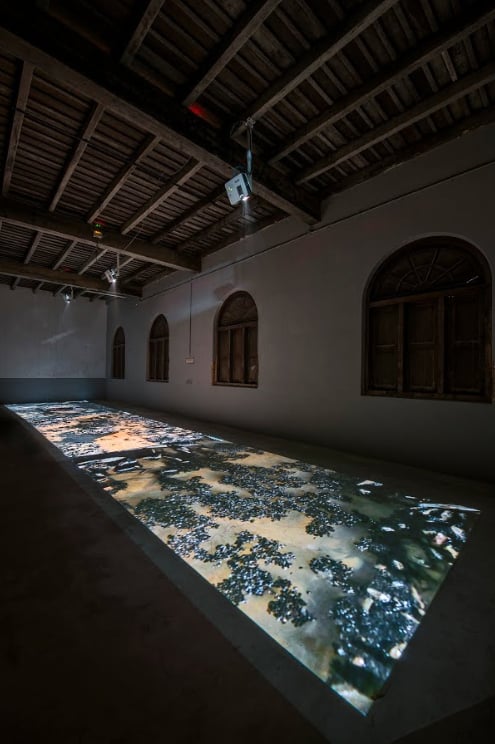
In response to the concept proposed by Jitish Kallat, artistic director of the second edition, titled Whorled Explorations, artists played upon metaphors of oceanic trade and of water as a psychic metaphor. These included the painting Gandhi and Gama (2014) by Gulammohammed Sheikh, which, showing the Portuguese navigator Vasco da Gama in the court of Mughal emperor Jahangir, pits a figure representing colonization against that of independence. Pushpamala N’s performative photo enactment The Arrival of Vasco da Gama (after an 1898 oil painting by Jose Veloso Salgado) (2014), a tableau representing Vasco da Gama in the court of the Zamorin, the ruler of Kochi, gives an elegiac spin to the colonial entry into India. A number of works reimagined Kochi’s seafaring history.
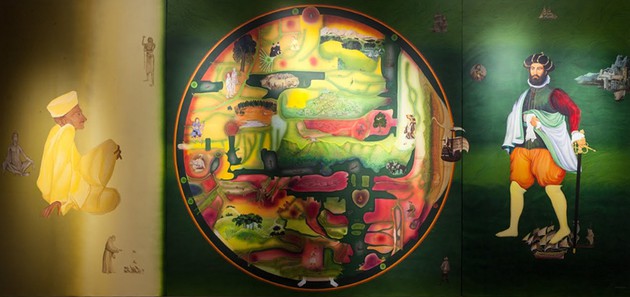
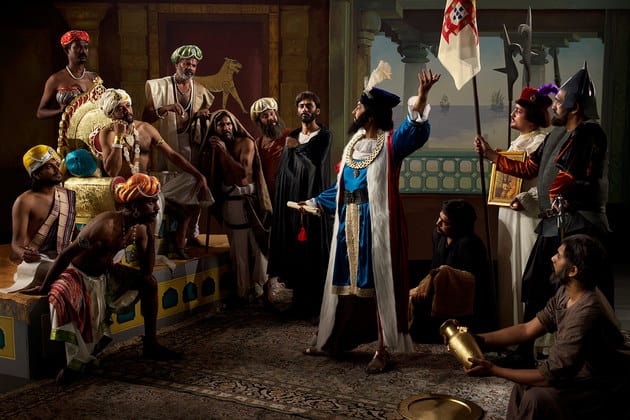
But if, as Hou Hanru says, “Biennials of contemporary art inevitably have cultural and geopolitical ambitions” what does Kochi reveal about itself?8Hou Hanru, “Towards a new locality: Biennials and ‘Global Art,'” in The Manifesta Decade: Debates on Contemporary Art Exhibitions and Biennials in post-Wall Europe (Cambridge, Mass.: MIT Press, 2005), 57. Does its short history suggest points of comparison with the region’s ancient past as a determinant of its present? How does it calibrate its own position among biennials of South Asia?
Here I would like to offer the historic poetic evocation of Kochi as a metaphor and a possible reading of the biennial. Historically, the Kochi swaroopam was part of Tamilakam, a geographic region of southern peninsular India that dominated the poetic imaginary of the first millenium.9Romila Thapar, Cultural Pasts: Essays in Early Indian History (Oxford: Oxford University Press, 2000), 556–57. Tamil Sangam poetry, believed to have flourished from 300 BCE to 300 CE, was anthologized by 1000 CE. Sangam literature imagined five thinai, or geographic areas, that created an image field for poetry: kurinji (hilly region), palai (dry land), mullai (pastoral tracts), marutam(wetlands) and neital (coastal area). Remarkably, even from the second century onward, these were interpreted in ecocentric terms in Tamil Sangam literature, which pervaded all of southern India.
However Tamil Sangam literature did not create an equivalent word for the making of the cosmopolis, i.e., a word to describe the hub of culture and trade. Even as Kochi flourished, the idea of such cosmopolitan fort cities did not attract a poetic equivalent. Just as the ancient thinai did not acknowledge new urban sites, the first three editions of the biennial did not acknowledge that a siting of art can also be a site of exclusion. Romila Thapar, in Cultural Pasts, writes of the resentment that prevailed among the ancient Keralan communities lying interior to the coastline as the wine trade with Europe prospered. Even as the cosmopolis of Kochi and related port cities grew, the Aryanization of Kerala, brought about by Brahmin migrations from the north in the second to twelfth centuries, would dominate Kerala. Such migrations changed the balance of social relations. To quote from a contemporary Kerala history text book, “Some of the drawbacks of Aryan impact are the increased rigidity of the caste system, the deplorable conditions of the lower classes, the exploitation of the landed gentry.” And earlier “In the social sphere, they introduced the caste system on a classless society . . . There was a corresponding decline in the status of women.”10Sunil Kumar G, Kerala Society and Culture: Ancient and Medieval School of Distance Education (Manjeri:University of Calicut, 2014), 26–27.
The biennial by its very definition is a site of incremental knowledge as much as a claimant of cultural identity. Through its first three editions, Kochi-Muziris has addressed some of the masculinist positions of the past—seafaring, conquest, trade, and barter, as well as the establishment of global markets. Their principal address was directed to mapping and diaspora, East and West in dialogic exchange, time, and cosmology. In the fourth edition, the choice of Anita Dube, a female curator, introduces the dimension of gender sensibility, thereby restoring a kind of curatorial gender parity. There is then a possibility of building or even inverting the bridge akin to the akkam and puram of Tamil Sangam poetry, which translate as “home” and “the world.”11Ibid. Swaroopam, the term for kingdom, draws from the root swaroop, which translates as one’s own image, or a reflection of the self. The understanding of what the biennial may mean to its publics then offers different models of interpretation. In the six years since the biennial’s inception, the world has become a more dangerous place, Indian and global polity are under greater strain from right-wing movements. Here the feminine voice, or the ungendered one, may address issues of displacement, the agencies of domestic production, and a deeper imaginary of what constitutes art. Equally, through a shift in subject positions, relations to space and the history of the site will undergo a reenactment.
Further, as it enters its fourth edition, the biennial cannot afford to be an inventory of artworks that cursorily acknowledges the shifting tides of geopolitics. In 2018 India’s concerns are very present: the stress of internal migration (the second highest in the world after China), the Rohingya and Bangladeshi refugee crises, the state of religious minorities, and the eroding sense of individual liberties are all palpable concerns. Through the prism of gender, the possibility of an engaged dialogue between women across different cultures offers a real possibility. The biennial need not be a feminist crusade, but too few women have been represented, and unless their work is elaborated upon and generously laid out, it is unlikely to attract more critical and curatorial attention. Further, the artist and diaspora can return—Anish Kapoor had a major stay in Kochi but that was hardly enough to document India’s historic migrations. The theoretical premises of recent art criticism in South Asia—on what follows after the moment of postcolonialism, and our location in a post-global dialectic are also important gateways. To what extent are the issues represented at the Kochi-Muziris Biennale, Dhaka Art Summit, and Lahore Biennale synchronous? In a troubled political region of closed borders, does art open up a new gateway for dialogue?
In effect, we may then consider the biennial as a site of compassion and engagement, one that can build upon its own history by accommodating that of others.
- 1Carolee Thea, “Okwui Enwezor,” in On Curating: Interviews with Ten International Curators (New York: D.A.P./Distributed Art Publishers, 2009), 10.
- 2Anthony Gardner and Charles Green, Biennials, Triennials, and Documenta: The Exhibitions that Created Contemporary Art (Hoboken, NJ: Wiley-Blackwell, 2016).
- 3The Southen states are: Andhra Pradesh, Tamil Nadu, Karnataka, and Kerala.
- 4Marek Bartelik, “An Emerging Paradigm Derived from the Asian Biennials? The Case Studies of the Mediacity Biennial (Seoul), the Busan Biennale (Busan), the Gwangju Biennale (Gwangju), and the Taipei Biennial (Taipei),”Journal of Taipei Fine Arts Museum (2014).
- 5Pliny’s Natural History, trans. Henry T. Riley, vol. 6, An Account of Countries, Nations, Seas, Towns, Havens, Mountains, Rivers, Distances, and Peoples Who Now Exist, or Formerly Existed (London: H. G. Bohn, 1855), chap. 26 “Voyages to India,” http://data.perseus.org/citations/urn:cts:latinLit:phi0978.phi001.perseus- eng1:6.26. “If the wind, called Hippalus, happens to be blowing, it is possible to arrive in forty days at the nearest mart of India, Muziris by name.”
- 6Vijayalekshmy. M, Trade and trading centres in Kerala (A.D 800-1500) (Calicut, India: Department of History, University of Calicut, 1997), 211.
- 7K. V. Krishna Aiyar, The Zamorins of Calicut: From the Earliest Times Down to A.D. 1806 (Calicut, India: Norman Printing Bureau, 1935), 85. See also O. K. Nambiar, Our Seafaring in the the [sic] Indian Ocean (Bangalore: Jeevan Publications, c. 1975), 35.
- 8Hou Hanru, “Towards a new locality: Biennials and ‘Global Art,'” in The Manifesta Decade: Debates on Contemporary Art Exhibitions and Biennials in post-Wall Europe (Cambridge, Mass.: MIT Press, 2005), 57.
- 9Romila Thapar, Cultural Pasts: Essays in Early Indian History (Oxford: Oxford University Press, 2000), 556–57.
- 10Sunil Kumar G, Kerala Society and Culture: Ancient and Medieval School of Distance Education (Manjeri:University of Calicut, 2014), 26–27.
- 11Ibid.
